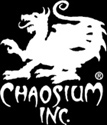
Call of Cthulhu is a horror fiction role-playing game based on H. P. Lovecraft's story of the same name and the associated Cthulhu Mythos. The game, often abbreviated as CoC, is published by Chaosium; it was first released in 1981 and is in its seventh edition, with licensed foreign language editions available as well. Its game system is based on Chaosium's Basic Role-Playing (BRP) with additions for the horror genre. These include special rules for sanity and luck.

Chaosium Inc. is a publisher of tabletop role-playing games established by Greg Stafford in 1975. Chaosium's major titles include Call of Cthulhu, based on the horror fiction stories of H. P. Lovecraft, RuneQuest Glorantha, Pendragon, based on Thomas Mallory's Le Morte d'Arthur, and 7th Sea, "swashbuckling and sorcery" set in a fantasy 17th century Europe.

Monte Cook is an American professional tabletop role-playing game designer and writer, best known for his work on Dungeons & Dragons.
The d20 System is a role-playing game system published in 2000 by Wizards of the Coast, originally developed for the 3rd edition of Dungeons & Dragons. The system is named after the 20-sided dice which are central to the core mechanics of many actions in the game.

Jonathan Tweet is an American game designer who has been involved in the development of the role-playing games Ars Magica, Everway, Over the Edge, Talislanta, the third edition of Dungeons & Dragons and 13th Age, and the collectible miniatures game Dreamblade. In 2015 Tweet released Grandmother Fish, a full-color, full-sized book about evolution aimed at preschoolers. In 2018 Tweet released Clades and Clades Prehistoric, two card games for children and adults which demonstrate the concept of a clade.

Keith Baker is an American game designer and fantasy novel author. In addition to working with Wizards of the Coast on the creation of Eberron, he has also contributed material for Goodman Games, Paizo Publishing and Green Ronin Publishing. In 2014, Baker and Jennifer Ellis co-founded the indie tabletop game company Twogether Studios.

Atlantis is a fantasy role-playing game (RPG) originally published by Bard Games, set in the ancient world before Atlantis sank. It first consisted of three books: The Arcanum, The Lexicon, and The Bestiary, and for this reason was originally called The Atlantean Trilogy or The Atlantis Trilogy.

Robin D. Laws is a Canadian writer and game designer who lives in Toronto, Canada. He is the author of a number of novels and role-playing games as well as an anthologist.

Green Ronin Publishing is an American company based in Seattle, Washington. Founded in 2000 by Chris Pramas and Nicole Lindroos, they have published several role-playing game–related products. They won several awards for their games including multiple Origins, ENnie, Pen & Paper, and Inquest Fan Awards.
Atlas Games is a company which publishes role-playing games, board games and card games. Its founder and current president is John Nephew.

Rob Heinsoo is an American tabletop game designer. He has been designing and contributing to professional role-playing games, card games, and board games since 1994. Heinsoo was the lead designer on the 4th Edition of Dungeons & Dragons (2008), and is co-designer of the 13th Age roleplaying game along with Jonathan Tweet. He has also designed and contributed to role playing, miniatures and card games, and a computer game.

Goodman Games is an American game publisher best known for the Dungeon Crawl Classics series of adventure modules and role-playing game, its science fiction offshoot Mutant Crawl Classics, and Original Adventures Reincarnated, a line of updated, annotated, and expanded republications of classic RPG adventures and supplements, mostly from TSR, Inc.'s Advanced Dungeons & Dragons. Additionally, Goodman Games produces RPGs using versions of the DCC rules for Fritz Leiber's Lankhmar and Jack Vance's Dying Earth settings, under license. The company has also produced licensed adventures for Wicked Fantasy Factory, Judges Guild, Xcrawl, Iron Heroes, Castles and Crusades, and Death Dealer.

The Pathfinder Roleplaying Game is a fantasy role-playing game (RPG) that was published in 2009 by Paizo Publishing. The first edition extends and modifies the System Reference Document (SRD) based on the revised 3rd edition Dungeons & Dragons (D&D) published by Wizards of the Coast under the Open Game License (OGL) and is intended to be backward-compatible with that edition.

Robert J. Schwalb is a writer in the role-playing game industry, and has worked as a game designer and developer for such games as Dungeons & Dragons, A Song of Ice and Fire Roleplaying, Warhammer Fantasy Roleplay, and many other RPG supplements.
Owen K.C. Stephens is a game designer who has worked on a number of products for the Starfinder, Pathfinder and Star Wars Roleplaying Game and other games.
Dungeons & Dragons retro-clones are fantasy role-playing games that emulate earlier editions of Dungeons & Dragons (D&D) no longer supported by Wizards of the Coast. They are made possible by the release of later editions' rules in a System Reference Document under the terms of the Open Game License, which allow the use of much of the proprietary terminology of D&D that might otherwise collectively constitute copyright infringement. However, per the license, these games lack the brand names Dungeons & Dragons, D&D, and all the other trademarks associated with those brands.
Free RPG Day is an annual promotional event by the Tabletop role-playing game industry. The event rules are fairly simple: participating publishers provide special free copies of games to participating game stores; the game store agrees to provide one free game to any person who requests a free game on Free RPG Day.

Ashen Stars is a gritty space opera role-playing game published by Pelgrane Press in 2011.

Kobold Press, also known as Open Design, is an American game company that produces role-playing games and game supplements.
This is a complete list of works by American science fiction and fantasy author Margaret Weis.















